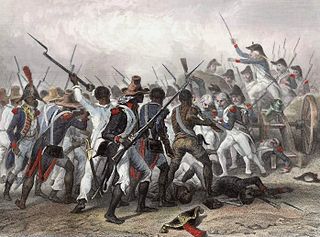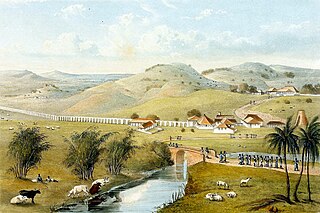Related Research Articles

The Baptist War, also known as the Sam Sharp Rebellion, the Christmas Rebellion, the Christmas Uprising and the Great Jamaican Slave Revolt of 1831–32, was an eleven-day rebellion that started on 25 December 1831 and involved up to 60,000 of the 300,000 slaves in the Colony of Jamaica. The uprising was led by a black Baptist deacon, Samuel Sharpe, and waged largely by his followers. The revolt, though militarily unsuccessful, played a major part in the abolition of slavery throughout the British Empire.


Queen Nanny, Granny Nanny, or Nanny of the Maroons ONH, was an 18th-century leader of the Jamaican Maroons. She led a community of formerly enslaved Africans called the Windward Maroons. In the early 18th century, under the leadership of Nanny, the Windward Maroons fought a guerrilla war over many years against British authorities in the Colony of Jamaica in what became known as the First Maroon War.
The First Maroon War was a conflict between the Jamaican Maroons and the colonial British authorities that started around 1728 and continued until the peace treaties of 1739 and 1740. It was led by self-liberated Africans who set up communities in the mountains. The name "Maroon" was given to these Africans, and for many years they fought the British colonial Government of Jamaica for their freedom. The maroons were very skilled, particularly in guerrilla warfare. It was followed about half a century later by the Second Maroon War.

The Second Maroon War of 1795–1796 was an eight-month conflict between the Maroons of Cudjoe's Town, a Maroon settlement later re-named after Governor Edward Trelawny at the end of First Maroon War, located near Trelawny Parish, Jamaica in the St James Parish, and the British colonials who controlled the island. The Windward communities of Jamaican Maroons remained neutral during this rebellion and their treaty with the British still remains in force. Accompong Town, however, sided with the colonial militias, and fought against Trelawny Town.

Tacky's War, Tacky's Revolt, or Tacky's Rebellion was a widespread fight for their freedom by enslaved people in the British Colony of Jamaica in the 1760s. Led by Akan people —tribes including Ashanti, Fanti, Nzema and Akyem—it was loosely led by a Fanti royal and warlord called Tacky (TwiTakyi) in eastern Jamaica, and Dahomean war chief or coastal headman Apongo in the western end of the island.
Jamaican Maroons descend from Africans who freed themselves from slavery on the Colony of Jamaica and established communities of free black people in the island's mountainous interior, primarily in the eastern parishes. Africans who were enslaved during Spanish rule over Jamaica (1493–1655) may have been the first to develop such refugee communities.
Moore Town is a Maroon settlement located in the Blue Mountains and John Crow Mountains of Portland, Jamaica, accessible by road from Port Antonio. The easternmost Maroon town, Moore Town is located in the eastern end of the parish. Formerly known as New Nanny Town, Moore Town was founded in 1740 when the Peace Treaty was signed between the British colonial authorities and the Windward Maroons. This treaty allotted the Moore Town Maroons 1000 acres, but Moore Town only received 500. In 1781 the initial 500 acres was augmented with another 500 acres, taking their communal land up to 1,000 acres.

The Crown Colony of Jamaica and Dependencies was a British colony from 1655, when it was captured by the English Protectorate from the Spanish Empire. Jamaica became a British colony from 1707 and a Crown colony in 1866. The Colony was primarily used for sugarcane production, and experienced many slave rebellions over the course of British rule. Jamaica was granted independence in 1962.

Cudjoe's Town was located in the mountains in the southern extremities of the parish of St James, close to the border of Westmoreland, Jamaica.
Quao was one of the leaders of the Windward Maroons, who fought the British colonial forces of Jamaica to a standstill during the First Maroon War of the 1730s. The name Quao is probably a variation of Yaw, which is the Twi Akan name given to a boy born on a Thursday.
Samuel Grant (1741-1808), Maroon officer from Charles Town, Jamaica. Sam Grant was an officer of the Jamaican Maroons who made a career out of hunting runaway slaves.
Three-Fingered Jack a.k.a. Jack Mansong, led a band of runaway slaves in the Colony of Jamaica in the eighteenth century.
Montague James was a Maroon leader of Cudjoe's Town in the last decade of eighteenth-century Jamaica. It is possible that Maroon colonel Montague James took his name from the white superintendent of Trelawny Town, John Montague James.
Cuffee was an escaped slave in Jamaica who led other runaway slaves to form a community of Free black people in Jamaica in the island's forested interior, and they raided white plantation owners at the end of the eighteenth century. The name Cuffee is a variation of the Twi Akan name Kofi, which is the name given to a boy born on a Friday.
Andrew Smith was a Maroon officer from Cudjoe's Town. His brother, Charles Samuels, was also an officer from Trelawny Town, and both officers reported to Colonel Montague James.
Crawford's Town was one of the two main towns belonging to the Windward Maroons, who fought a guerrilla war of resistance against the British colonial forces of Jamaica during the First Maroon War of the 1730s.
Charles Town is one of four official towns of the Jamaican Maroons. It is located on Buff Bay River in Portland Parish.
Scott's Hall is one of the four official towns of the Jamaican Maroons. It is located in Saint Mary Parish, Jamaica.
Free black people in Jamaica fell into two categories. Some secured their freedom officially, and lived within the slave communities of the Colony of Jamaica. Others ran away from slavery, and formed independent communities in the forested mountains of the interior. This latter group included the Jamaican Maroons, and subsequent fugitives from the sugar and coffee plantations of coastal Jamaica.
References
- ↑ Michael Siva, After the Treaties: A Social, Economic and Demographic History of Maroon Society in Jamaica, 1739-1842, PhD Dissertation (Southampton: Southampton University, 2018), pp. 71-3.
- ↑ "Tacky's Slave Rebellion". 26 March 2004.
- ↑ "Tacky above some heroes". jamaica-gleaner.com. 2013-10-13. Retrieved 2023-08-31.
- ↑ Hinks, Peter P. (2007). Encyclopedia of Antislavery and Abolition. Greenwood Press. ISBN 978-0-313-33144-2.
- ↑ Rodriguez, Junius P. (2015-03-26). Encyclopedia of Emancipation and Abolition in the Transatlantic World. Routledge. ISBN 978-1-317-47179-0.
- ↑ Michael Craton, Testing the Chains (New York: Cornell University Press, 1982), p. 136.
- ↑ Siva, After the Treaties, pp. 103-4.
- ↑ O'Shaughnessy, Andrew Jackson (2000). An Empire Divided: The American Revolution and the British Caribbean. University of Pennsylvania Press. ISBN 9780812217322.
- ↑ Siva, After the Treaties, p. 75. https://eprints.soton.ac.uk/423482/1/LIBRARY_COPY_After_The_Treaties_Final.pdf
- ↑ Siva, After the Treaties, p. 114.
- ↑ Siva, After the Treaties, p. 73.